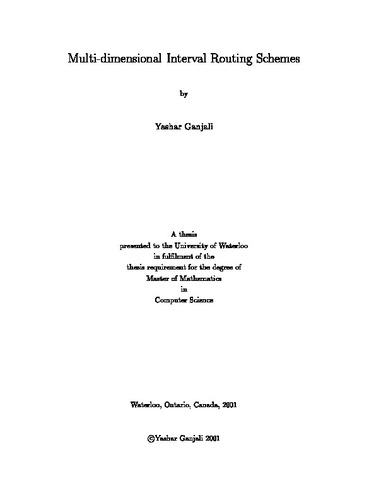| dc.contributor.author | Ganjali, Yashar | en |
| dc.date.accessioned | 2006-08-22 14:26:22 (GMT) | |
| dc.date.available | 2006-08-22 14:26:22 (GMT) | |
| dc.date.issued | 2001 | en |
| dc.date.submitted | 2001 | en |
| dc.identifier.uri | http://hdl.handle.net/10012/1207 | |
| dc.description.abstract | Routing messages between pairs of nodes is one of the most fundamental tasks in any distributed computing system. An Interval Routing Scheme (IRS) is a well-known, space-efficient routing strategy for routing messages in a network. In this scheme, each node of the network is assigned an integer label and each link at each node is labeled with an interval. The interval assigned to a link l at a node v indicates the set of destination addresses of the messages which should be forwarded through l at v. When studying interval routing schemes, there are two main problems to be considered: a) Which classes of networks do support a specific routing scheme? b) Assuming that a given network supports IRS, how good are the paths traversed by messages? The first problem is known as the characterization problem and has been studied for several types of IRS. In this thesis, we study the characterization problem for various schemes in which the labels assigned to the vertices are d-ary integer tuples (d-dimensional IRS) and the label assigned to each link of the network is a list of d 1-dimensional intervals. This is known as Multi-dimensional IRS (MIRS) and is an extension of the the original IRS. We completely characterize the class of network which support MIRS for linear (which has no cyclic intervals) and strict (which has no intervals assigned to a link at a node v containing the label of v) MIRS. In real networks usually the costs of links may vary over time (dynamic cost links). We also give a complete characterization for the class of networks which support a certain type of MIRS which routes all messages on shortest paths in a network with dynamic cost links. The main criterion used to measure the quality of routing (the second problem) is the length of routing paths. In this thesis we also investigate this problem for MIRS and prove two lower bounds on the length of the longest routing path. These are the only known general results for MIRS. Finally, we study the relationship between various types of MIRS and the problem of drawing a hypergraph. Using some of our results we prove a tight bound on the number of dimensions of the space needed to draw a hypergraph. | en |
| dc.format | application/pdf | en |
| dc.format.extent | 617196 bytes | |
| dc.format.mimetype | application/pdf | |
| dc.language.iso | en | en |
| dc.publisher | University of Waterloo | en |
| dc.rights | Copyright: 2001,
Ganjali, Yashar. All rights reserved. | en |
| dc.subject | Computer Science | en |
| dc.subject | Computer networks | en |
| dc.subject | interval routing schemes | en |
| dc.subject | graph theory | en |
| dc.subject | multi-dimensional | en |
| dc.subject | characterization | en |
| dc.subject | bounds | en |
| dc.title | Multi-dimensional Interval Routing Schemes | en |
| dc.type | Master Thesis | en |
| dc.pending | false | en |
| uws-etd.degree.department | School of Computer Science | en |
| uws-etd.degree | Master of Mathematics | en |
| uws.typeOfResource | Text | en |
| uws.peerReviewStatus | Unreviewed | en |
| uws.scholarLevel | Graduate | en |

